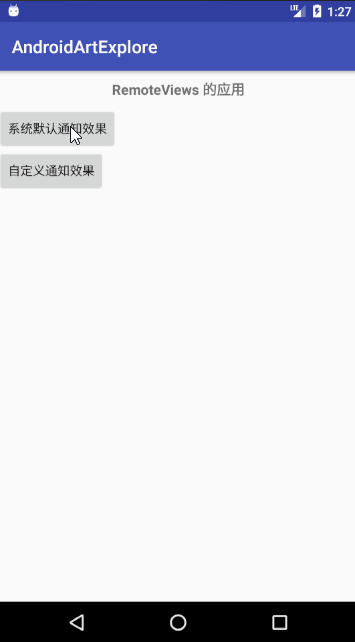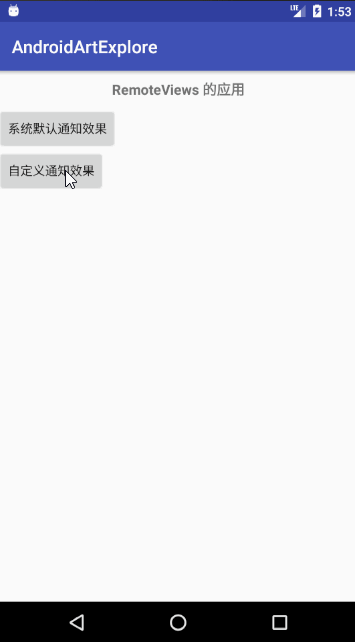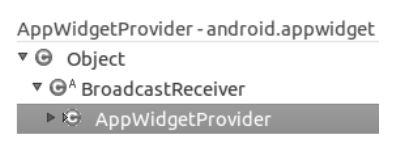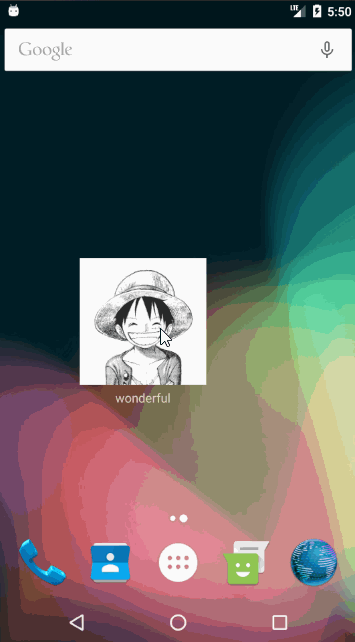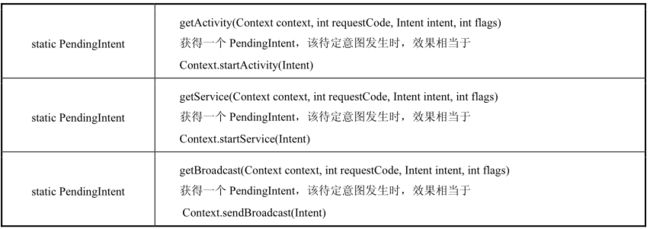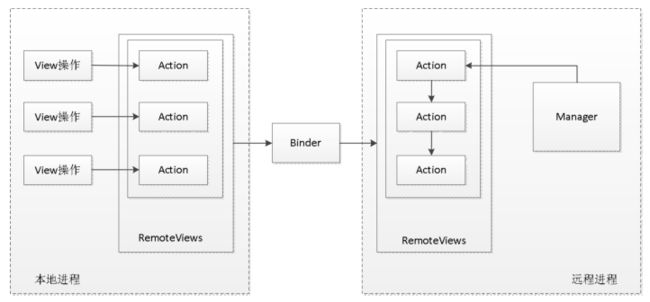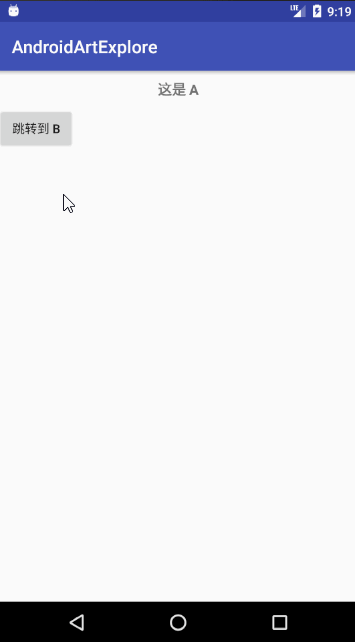本篇文章主要介绍以下几个知识点:
- RemoteViews 的应用
- RemoteViews 的内部机制
- RemoteViews 的意义
RemoteViews 表示的是一种 View 的结构,它可以在其他的进程中显示,其使用场景有两种:通知栏和桌面小部件。
5.1 RemoteViews 的应用
5.1.1 RemoteViews 在通知栏上的应用
通知栏除了默认效果还支持自定义布局,使用系统默认的样式弹出一个通知如下:
/**
* 系统默认样式
*/
private void defaultNotice() {
Intent intent = new Intent(this, NoticeActivity.class);
PendingIntent pi = PendingIntent.getActivity(this,0,intent,0);
// 1. 获取 NotificationManager 实例来对通知进行管理
NotificationManager manager = (NotificationManager) getSystemService(NOTIFICATION_SERVICE);
// 2. 使用 Builder 构造器来创建 Notification 对象
Notification notification = new NotificationCompat.Builder(this)
.setContentTitle("This is content title")
.setContentText("This is content text")
.setWhen(System.currentTimeMillis())
.setSmallIcon(R.mipmap.ic_launcher)
.setLargeIcon(BitmapFactory.decodeResource(getResources(),R.mipmap.ic_launcher))
.setContentIntent(pi) // 传入pi
.build();
// 3. 显示通知
manager.notify(1,notification);
}
运行效果如下:
为了满足个性化需求,需要用到自定义通知,首先提供一个布局文件,然后通过 RemoteViews 加载这个布局文件即可,如下:
/**
* 自定义通知栏
*/
private void customizeNotice() {
Intent intent = new Intent(this, NoticeActivity.class);
PendingIntent pi = PendingIntent.getActivity(this,0,intent,0);
RemoteViews remoteViews = new RemoteViews(getPackageName(), R.layout.chapter05_notice_item_layout);
remoteViews.setTextViewText(R.id.tv_title, "This is content title"); // 文字
remoteViews.setTextViewText(R.id.tv_content, "This is content text");// 文字
remoteViews.setImageViewResource(R.id.iv_notice, R.mipmap.ic_notice);// 图片
remoteViews.setOnClickPendingIntent(R.id.ll_open_notice, pi); // 点击
// 1. 获取 NotificationManager 实例来对通知进行管理
NotificationManager manager = (NotificationManager) getSystemService(NOTIFICATION_SERVICE);
// 2. 使用 Builder 构造器来创建 Notification 对象
Notification notification = new NotificationCompat.Builder(this)
.setContent(remoteViews) // 传入 remoteViews
.setSmallIcon(R.mipmap.ic_notice)
.setWhen(System.currentTimeMillis())
.build();
// 3. 显示通知
manager.notify(2, notification);
}
其中布局文件代码如下:
运行效果如下:
5.1.2 RemoteViews 在桌面小部件的应用
AppWidgetProvider 是 Android 中提供的用于实现桌面小部件的类,其本质是一个广播,即 BroadcastReceiver,其继承关系如下:
桌面小部件的开发步骤如下:
1. 定义小部件的界面
在 res/layout 下新建个 widget.xml (名称和内容可自定义)如下:
2. 定义小部件配置信息
在 res/xml 下新建 widget_info.xml (名称可自定义)如下:
3. 定义小部件的实现类
这个类需继承 AppWidgetProvider 如下:
/**
* Function:小部件的实现类
* Author:Wonderful on 2017/8/16 10:50
* Email:[email protected]
*/
public class MyWidgetProvider extends AppWidgetProvider{
public static final String CLICK_ACTION = "com.wonderful.androidartexplore.chapter05.action.CLICK";
public MyWidgetProvider() {
super();
}
@Override
public void onReceive(final Context context, final Intent intent) {
super.onReceive(context, intent);
// 判断是自己的 action,做自己的事情,如小部件被单击了要干什么,
// 这里是做一个动画效果
if (intent.getAction().equals(CLICK_ACTION)) {
ToastUtils.show("clicked it");
new Thread(new Runnable() {
@Override
public void run() {
Bitmap bitmap = BitmapFactory.decodeResource(context.getResources(), R.mipmap.ic_header);
AppWidgetManager appWidgetManage = AppWidgetManager.getInstance(context);
for (int i = 0; i < 37; i++) {
float degree = (i * 10) % 360;
RemoteViews remoteViews = new RemoteViews(context.getPackageName(), R.layout.widget);
remoteViews.setImageViewBitmap(R.id.iv_widget, rotateBitmap(bitmap, degree));
Intent intentClick = new Intent(CLICK_ACTION);
PendingIntent pendingIntent = PendingIntent.getBroadcast(context, 0, intentClick, 0);
remoteViews.setOnClickPendingIntent(R.id.iv_widget, pendingIntent);
appWidgetManage.updateAppWidget(new ComponentName(context, MyWidgetProvider.class), remoteViews);
SystemClock.sleep(30);
}
}
}).start();
}
}
/**
* 每次桌面小部件更新时都会调用一次该方法
*/
@Override
public void onUpdate(Context context, AppWidgetManager appWidgetManager, int[] appWidgetIds) {
super.onUpdate(context, appWidgetManager, appWidgetIds);
for (int appWidgetId : appWidgetIds) {
RemoteViews remoteViews = new RemoteViews(context.getPackageName(), R.layout.widget);
// 点击桌面小部件发送广播
Intent intentClick = new Intent(CLICK_ACTION);
PendingIntent pendingIntent = PendingIntent.getBroadcast(context, 0, intentClick, 0);
remoteViews.setOnClickPendingIntent(R.id.iv_widget, pendingIntent);
appWidgetManager.updateAppWidget(appWidgetId, remoteViews);
}
}
/**
* 动画
*/
private Bitmap rotateBitmap(Bitmap bitmap, float degree) {
Matrix matrix = new Matrix();
matrix.reset();
matrix.setRotate(degree);
return Bitmap.createBitmap(bitmap, 0, 0, bitmap.getWidth(), bitmap.getHeight(), matrix, true);
}
}
上述代码实现了一个简单的桌面小部件,小部件上显示一张图片,点击后旋转一周。
4. 在 AndroidManifest.xml 中声明小部件
桌面小部件本质是一个广播组件,必须要注册,如下:
运行效果如下:
上面描述了一个开发桌面小部件的完整过程,实际开发流程都是一样的。 不管小部件的界面初始化还是界面的更新,在界面上的操作都是通过 RemoteViews。
AppWidgetProvider 除了最常用的 onUpdate 方法,还有 onEnable,onDisabled,onDeleted以及onReceiver 方法,这些方法会自动的被 onReceiver 在合适的时间调用,其含义如下:
onEnable 当该窗口小部件第一次添加到桌面的时候调用该方法,可添加多次但是只在第一次调用
onUpdate 小部件被添加或每次更新时都会调用一次该方法,更新机制由 updatePeriodMillis 来指定
onDeleted 每删除一次小部件就调用一次
onDisabled 当最后一个该类型的小部件被删除时调用
onReceiver 广播内置的方法
5.1.3 PendingIntent 概述
PendingIntent 表示一种处于待定、等待、即将发生的意思,它与 Intent 的区别在于,PendingIntent 是在将来某个不确定的时刻发生,Intent 是立刻发生。(给 RemoteViews 设置点击事件必须使用 PendingIntent)
PendingIntent 支持三种待定意图:启动Activity、启动Service、发送广播,具体如下:
上图中三个方法的参数都是一样的,其中第二个参数 requstCode 表示 PendingIntent 发送方的请求码,多数情况设为 0,它也会影响到参数 flags 的效果。
PendingIntent 的匹配规则:若两个 PendingIntent 内部的 Intent 相同并且 requstCode 也相同,那么这两个 PendingIntent 就是相同的。
Intent 的匹配规则:若两个 Intent 的 ComponentName 和 intent-filter 都相同,那么这两个 intent 就是相同的。(注:Extras 不参与匹配过程)
下面介绍参数 flags 的含义:
FLAG_ONE_SHOT
当前 PendingIntent 只能被使用一次,然后被 cancel,若后续还有相同的 PendingIntent,则无效。通知栏,同类的通知只能使用一次,后续的无法打开。FLAG_NO_CREATE
当前 PendingIntent 不会主动去创建,若之前不存在,则获取 PendingIntent 失败(实际中无意义)。FLAG_CANCEL_CURRENT
当前 PendingIntent 若已存在,则会被 cancel,然后系统会创建一个新的 PendingIntent。通知栏,那些被 cancel 的消息将无法被打开。FLAG_UPDATE_CURRENT
当前 PendingIntent 若已存在,则会被更新,即它们的 intent 中的 Extras 会被替换成最新的。
下面结合通知栏信息描述这四个标记位,如下代码:
// 若 notify 的第一个参数 id 是常量,多次调用 notify 只弹出一个通知,后续的会把前面的替换掉
// 若每次 id 都不同,多次调用 notify 会弹出多个通知
manager.notify(1, notification);
若 notify 的 id 是常量,不管 PendingIntent 是否匹配,后面的通知会替换前面的通知。
若 notify 的 id 每次都不同,当 PendingIntent不匹配时,通知之间不互相干扰。PendingIntent 处于匹配状态时,分如下情况:
- FLAG_ONE_SHOT 后续通知中的 PendingIntent 会和第一条通知保持一致,包括其中的 Extras,单击任何一条通知后,剩余的都无法打开,当所有通知被清除后,会重复此过程
- FLAG_CANCEL_CURRENT 只有最新的通知可以打开,之前弹出均无法打开
- FLAG_UPDATE_CURRENT 之前弹出的通知中的 PendingIntent 会被更新,最终它们和最新的一条通知保持一致,包括其中的Extras,这些通知都可以被打开
5.2 RemoteViews 的内部机制
RemoteViews 的作用在其他进程中显示并且更新 View 的界面,其最常用的构造方法:
// 两个参数:第一个表示当前的包名,第二个是待加载的布局文件
public RemoteViews(String packageName, int layoutId) {
this(getApplicationInfo(packageName, UserHandle.myUserId()), layoutId);
}
RemoteViews 支持的所有 View 类型如下:
RemoteViews 中不能使用除了上述列表中以外的 View,也无法使用自定义 View。
RemoteViews 没有提供 findViewById 方法,无法直接访问里面的 View 元素,必须通过它所提供的一系列 set 方法来完成。其部分 set 方法如下:
关于 RemoteViews 的内部机制,有兴趣的可以去看看书或源码,这里提供一张图,不多做介绍了:
5.3 RemoteViews 的意义
下面打造一个模拟的通知栏效果并且实现跨进程的 UI 更新。
有两个 Activity 分别运行在两个不同的进程,一个是A,一个是B,其中A扮演着通知栏的角色,而B则可以不停地发送通知栏消息。为了模拟通知栏的效果,修改A的 process 属性使其运行在单独的进程中,这样A和B就构成了多进程通信的情形。在B中创建 Remoteviews 对象,然后通知A显示这个 RemoteViews 对象。
B每发送一次模拟通知,就会发送一个特定的广播,然后A接收到广播后就开始显示B中定义的 RemoteViews 对象,此过程和系统的通知栏消息的显示过程几乎一致。
首先看B的实现,B只要构造 RemoteViews 对象并将其传输给A即可,代码如下:
/**
* Function:模拟通知效果 B activity
* Author:Wonderful on 2017/8/9 10:30
* Email:[email protected]
*/
public class B_Activity extends BaseActivity {
@Override
protected int initLayoutId() {
return R.layout.activity_chapter05_b;
}
@Override
protected void initView() {
}
@OnClick(R.id.btn_send)
public void onViewClicked() {
ToastUtils.show("发送广播");
RemoteViews remoteViews = new RemoteViews(getPackageName(), R.layout.chapter05_notice_item_layout);
remoteViews.setTextViewText(R.id.tv_title, "发送给 A 的通知");
remoteViews.setTextViewText(R.id.tv_content, "mag from process:" + Process.myPid());
//remoteViews.setImageViewResource(R.id.iv_notice, R.mipmap.ic_notice);
PendingIntent pendingIntent = PendingIntent.getActivity(this, 0, new Intent(this, A_Activity.class), PendingIntent.FLAG_UPDATE_CURRENT);
PendingIntent pendingIntent2 = PendingIntent.getActivity(this, 0, new Intent(this, NoticeActivity.class), PendingIntent.FLAG_UPDATE_CURRENT);
remoteViews.setOnClickPendingIntent(R.id.iv_notice, pendingIntent);
remoteViews.setOnClickPendingIntent(R.id.ll_open_notice, pendingIntent2);
Intent intent = new Intent(Constants.REMOTE_ACTION);
// 将RemoteViews 对象通过Intent传输到A中
intent.putExtra(Constants.EXTRA_REMOTE_VIEWS, remoteViews);
sendBroadcast(intent);
}
}
A中只需接收B中的广播并显示 RemoteViews 即可,代码如下:
/**
* Function:模拟通知效果 A activity
* Author:Wonderful on 2017/8/9 10:30
* Email:[email protected]
*/
public class A_Activity extends BaseActivity {
@BindView(R.id.ll_remoteViews)
LinearLayout llRemoteViews;
@Override
protected int initLayoutId() {
return R.layout.activity_chapter05_a;
}
@Override
protected void initView() {
// 注册广播
IntentFilter intent = new IntentFilter(Constants.REMOTE_ACTION);
registerReceiver(mBroadcastReceiver, intent);
}
private BroadcastReceiver mBroadcastReceiver = new BroadcastReceiver() {
@Override
public void onReceive(Context context, Intent intent) {
LogUtils.e("A_activity", "接收广播成功");
// 1. 当收到广播后,从Intent中取出RemoteViews对象
RemoteViews remoteViews = intent.getParcelableExtra(Constants.EXTRA_REMOTE_VIEWS);
if (remoteViews != null) {
// 2. 通过apply方法加载布局并且执行更新操作,
View view = remoteViews.apply(context, llRemoteViews);
// 3. 将得到的 View 添加到A的布局中
llRemoteViews.addView(view);
}
}
};
@Override
protected void onDestroy() {
super.onDestroy();
// 解除广播
unregisterReceiver(mBroadcastReceiver);
}
@OnClick(R.id.btn_to_b)
public void onViewClicked() {
// 跳转到 B activity
IntentUtils.to(this, B_Activity.class);
}
}
运行效果如下:
现有两应用,一个应用能更新另一个应用中的某个界面,这时可选择以下两种方式实现:
- AIDL 缺点:当对界面的更新频繁时,会有效率问题,同时 AIDL 接口会变得复杂。
- RemoteViews 缺点:只支持一些常见的View,不支持自定义 View。
面对这种问题,若界面中的 View 是一些简单的且被 RemoteViews 支持的 View,可考虑采用 RemoteViews,否则就不适合用 RemoteViews。
采用 RemoteViews 来实现两应用间的界面更新,还有一个布局文件的加载问题。在上面的代码中,直接通过 RemoteViews 的 apply 方法来加载并更新界面:
// 2. 通过apply方法加载布局并且执行更新操作,
View view = remoteViews.apply(context, llRemoteViews);
// 3. 将得到的 View 添加到A的布局中
llRemoteViews.addView(view);
这种写法在同一个应用的多进程情形下是适用的,但若A和B属于不同应用,由于资源id不可能刚好一样,B中的布局文件的资源id传输到A中后可能无效。
面对这种情况,可通过资源名称来加载布局文件。
首先两个应用要提前约定好 RemoteViews 中的布局的文件名称,然后在A中根据名称找到并加载,接着再调用 Remoteviews 的 reapply 方法即可将B中对View所做的一系列更新操作全作用到A中加载的View上。修改后的代码如下:
int layoutId = getResources().getIdentifier("layout_simulated_notification","layout",getPackageName());
View view = getLayoutInflater().inflate(layoutId,llRemoteViews,false);
remoteViews.reapply(this,view);
llRemoteViews.addView(view);
本篇文章就介绍到这。

